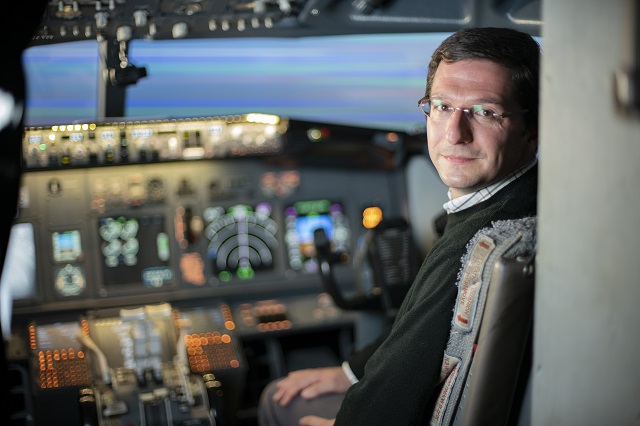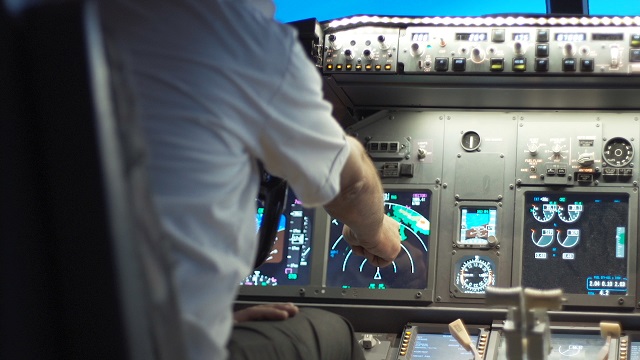Aviation turbulence can now be predicted up to 18 hours ahead, resulting in smoother flights for billions of passengers and helping to cut carbon dioxide emissions – all thanks to Professor Paul Williams’ research. His work has been recognised as runner-up for the Natural Environment Research Council (NERC) Societal Impact award. David Derbyshire reports.

Flying through a patch of severe and unexpected turbulence is an unforgettable, unsettling and sometimes painful experience for tens of thousands of passengers each year.
The aircraft shudders violently, your seat seems to fall away from beneath you and, if you’re not strapped in, you can quickly find yourself and your meal tray flying towards the cabin ceiling.
According to the best estimates, severe turbulence-related injuries account for 7,000 lost working days for flight attendants and turbulence costs the industry hundreds of millions of pounds a year. And, sometimes, it can be deadly. On smaller aircraft it is responsible for the deaths of around 40 people every year in the US alone.
Tackling the trouble of turbulence
Thanks to the work of Paul Williams, Professor of Atmospheric Science at the University of Reading, airlines have a smarter way to avoid disruptive mid-flight turbulence. With colleagues from the US, and with support from NERC, he has developed a forecasting system that better predicts areas of turbulence hours in advance, allowing pilots to redirect their flights onto smoother and safer journeys.
Turbulence is the leading cause of injuries to air passengers and flight attendants. Since our forecast model was adopted by US authorities in 2015, we estimate that it has helped improve the comfort and safety of flights on up to 2·5 billion passenger journeys.
While there are many forms of turbulence, some are more troublesome than others. A common form, called convective turbulence, occurs in and around thunderstorms. Powerful updrafts in the heart of a storm can push aircraft up or down by up to 100 feet. Thankfully, thunderstorms show up on radar and can be spotted by the human eye, making it relatively easy to avoid.
Avoiding the invisible

Far more challenging to pilots is clear-air turbulence, which is invisible and often strikes without warning.
Paul says: “It comes out of the blue, literally. Anyone who has flown a few times will have flown through it. It is the sort that can injure people if they are not wearing seatbelts.”
In May 2017, 27 people were hurt when Aeroflot flight SU270 hit clear-air turbulence while preparing to land at Bangkok. Some passengers broke bones as the plane plummeted and they were thrown into the ceiling. The violent buffeting can also damage aircraft. In December 1992, an aircraft hit a pocket of clear-air turbulence over Colorado which ripped out six metres of its left wing and removed one of its four engines.
Clear air turbulence is usually found at relatively high altitudes, typically above 20,000 feet. It is also closely linked to jet streams, the fast-moving, narrow bands of air that speed through the atmosphere several kilometres above ground.
The boundaries of jet streams – where the corridor of fast air meets the slower surrounding air – are unstable and chaotic, and scatter powerful swirls of wind into the surrounding atmosphere. If a plane flies through one of these swirls, the fast moving air will buffet its wings, making it suddenly lose or gain altitude.
Riding the gravity wave
However, the jet stream is just part of the picture. During Paul’s NERC-funded PhD at the University of Oxford in the early 2000s, he investigated the role of gravity waves in the creation of clear-air turbulence.
Atmospheric gravity waves are formed when the air is disrupted – for instance by being forced up over a mountain range or by a weather front. Parcels of air then move up and down like waves in the sea as the gravity waves flow across the skies. The atmosphere is full of them and they can sometimes be seen as striped clouds or large ripples on the surface of an ocean. If a jet stream on its own isn’t enough to unleash clear-air turbulence, the addition of powerful gravity waves in the same region of the atmosphere may do the job.

Paul developed a practical forecasting tool for clear-air turbulence that was adopted by the US authorities in 2015. The model looks 18 hours into the future to forecast the likely behaviour of the jet stream. It then uses an equation to reveal where gravity waves are being generated and where patches of clear-air turbulence are most likely to form. If there is moderate turbulence which affects aviation, the algorithm successfully forecasts it 83% of the time.
The model predicts all strengths of clear-air turbulence – from the lighter forms that cause shudders and shakes, to the rare, but potentially dangerous, ones that could cause injury to crew and passengers, or damage to aircraft. But, as well as reducing injury and damage, it has another benefit. Turbulence is the underlying cause of many people’s fear of flying – a phobia which affects up to four out of ten people.
Paul hopes that the model, which is freely available for anyone to use, will be adopted across the world. However, as aviation safety is tightly regulated, any changes won’t be immediate. The model is set to become more important in the future because Paul has also shown that clear-air turbulence is likely to be more common as the world continues to warm. He predicts that the amount of turbulence in the jet streams will have doubled or tripled by the period 2050-2080.
He says: “If this is the future of flying, it will be even more important that we give planes the chance to avoid potentially damaging turbulence.”
This article, by David Derbyshire, was first published on the Natural Environment Research Council’s website, 22 November 2018 (CC-BY-4.0)
